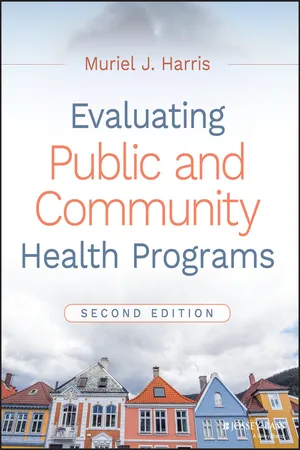
- English
- ePUB (mobile friendly)
- Available on iOS & Android
Evaluating Public and Community Health Programs
About this book
Evaluating Public and Community Health Programs provides a comprehensive introduction to the theory and practice of evaluation, with a participatory model that brings stakeholders together for the good of the program. Linking community assessment, program implementation, and program evaluation, this book emphasizes practical, ongoing evaluation strategies that connect theory with application. This updated second edition includes new discussion on planning policy change programs using logic models and theory of change, plus expanded coverage of processes, outcomes, data collection, and more. Each chapter includes classroom activities and group discussion prompts, and the companion website provides worksheets, lecture slides, and a test bank for instructors. Mini cases help illustrate the real-world applications of the methods described, and expanded case studies allow students to dig deeper into practice and apply what they've learned.
Accurate and effective evaluation is the key to a successful program. This book provides a thorough introduction to all aspects of this critical function, with a wealth of opportunities to apply new concepts.
- Learn evaluation strategies that involve all program stakeholders
- Link theory to practice with new mini cases and examples
- Understand the uses, processes, and approaches to evaluation
- Discover how ongoing evaluation increases program effectiveness
Public and community health programs are a vital part of our social infrastructure, and the more effective they are, the more people they can serve. Proper planning is important, but continued evaluation is what keeps a program on track for the long term. Evaluating Public and Community Health Programs provides clear instruction and insightful discussion on the many facets of evaluation, with a central focus on real-world service.
Frequently asked questions
- Essential is ideal for learners and professionals who enjoy exploring a wide range of subjects. Access the Essential Library with 800,000+ trusted titles and best-sellers across business, personal growth, and the humanities. Includes unlimited reading time and Standard Read Aloud voice.
- Complete: Perfect for advanced learners and researchers needing full, unrestricted access. Unlock 1.4M+ books across hundreds of subjects, including academic and specialized titles. The Complete Plan also includes advanced features like Premium Read Aloud and Research Assistant.
Please note we cannot support devices running on iOS 13 and Android 7 or earlier. Learn more about using the app.
Information
CHAPTER 1
AN INTRODUCTION TO PUBLIC AND COMMUNITY HEALTH EVALUATION
- Identify the uses and approaches of evaluation.
- Describe preassessment evaluation.
- List the principles of participatory evaluation.
- Describe the links among community assessment, program implementation, and program evaluation.
- Explain the ethical and cultural issues in evaluation.
- Describe the value and role of stakeholders in evaluation.
- Attain high quality, longer lives free of preventable disease, disability, injury, and premature death.
- Achieve health equity, eliminate disparities, and improve the health of all groups.
- Create social and physical environments that promote good health for all.
- Promote quality of life, healthy development, and healthy behaviors across all life stages. (http://www.healthypeople.gov/2020/About‐Healthy‐People)
- Evaluation is about a particular initiative. It is generally carried out for the purposes of assessing the initiative, and the results are not generalizable. However, with the scaling up of programs to reach increasingly large segments of the population, and with common outcome expectations and common measures, evaluations can increase their generalizability. Research traditionally aims to produce results that are generalizable to a whole population, place, or setting in a single experiment.
- Evaluations are designed to improve an initiative and to provide information for decision‐making at the program or policy level; research aims to prove whether there is a cause‐and‐effect relationship between two entities in a controlled situation.
- Evaluation questions are generally related to understanding why and how well an intervention worked, as well as to determining whether it worked. Research is much more focused on the end point, on whether an intervention worked and much less on the process for achieving the end result.
- Evaluation questions are identified by the stakeholders in collaboration with the evaluators; research questions are usually dictated by the researcher's agenda.
OVERVIEW OF EVALUATION
Consumer‐Based Approach
Decision‐Based Approach
Goal‐Free Approach
Participatory Approach
Expertise‐Oriented Approach
Objectives‐Based Approach
Table of contents
- Cover
- Title Page
- Copyright Page
- Table of Contents
- Dedication
- Preface
- Acknowledgments
- CHAPTER 1: AN INTRODUCTION TO PUBLIC AND COMMUNITY HEALTH EVALUATION
- CHAPTER 2: THE COMMUNITY ASSESSMENT: AN OVERVIEW
- CHAPTER 3: DEVELOPING INITIATIVES: AN OVERVIEW
- CHAPTER 4: PLANNING FOR EVALUATION: PURPOSE AND PROCESSES
- CHAPTER 5: DESIGNING THE EVALUATION: PART 1: DESCRIBING THE PROGRAM OR POLICY
- CHAPTER 6: DESIGNING THE EVALUATION: PART 2A: PROCESS EVALUATION
- CHAPTER 7: DESIGNING THE EVALUATION: PART 2B: OUTCOME EVALUATION
- CHAPTER 8: COLLECTING THE DATA: QUANTITATIVE
- CHAPTER 9: COLLECTING THE DATA: QUALITATIVE
- CHAPTER 10: ANALYZING AND INTERPRETING QUANTITATIVE AND QUALITATIVE DATA: QUANTITATIVE (PART 1)
- CHAPTER 11: REPORTING EVALUATION FINDINGS
- CHAPTER 12: CASE STUDY: THE COMMUNITY ASSESSMENT
- CHAPTER 13: CASE STUDY: PROCESS EVALUATION
- APPENDIX A: MODEL AGREEMENT BETWEEN EVALUATION CONSULTANT AND TEAM MEMBERS
- APPENDIX B: MODEL PREAMBLE FOR ADULT INDIVIDUAL INTERVIEWS
- APPENDIX C: MODEL DEMOGRAPHIC SHEET
- APPENDIX D: MODEL FIELD NOTES REPORT
- APPENDIX E: MODEL INTERVIEW REFUSAL REPORT
- APPENDIX F: DATA COLLECTION TRAINING MANUAL TEMPLATE
- APPENDIX G: GUIDELINES FOR COMPLETING AN EVALUATION REPORT
- REFERENCES
- INDEX
- End User License Agreement